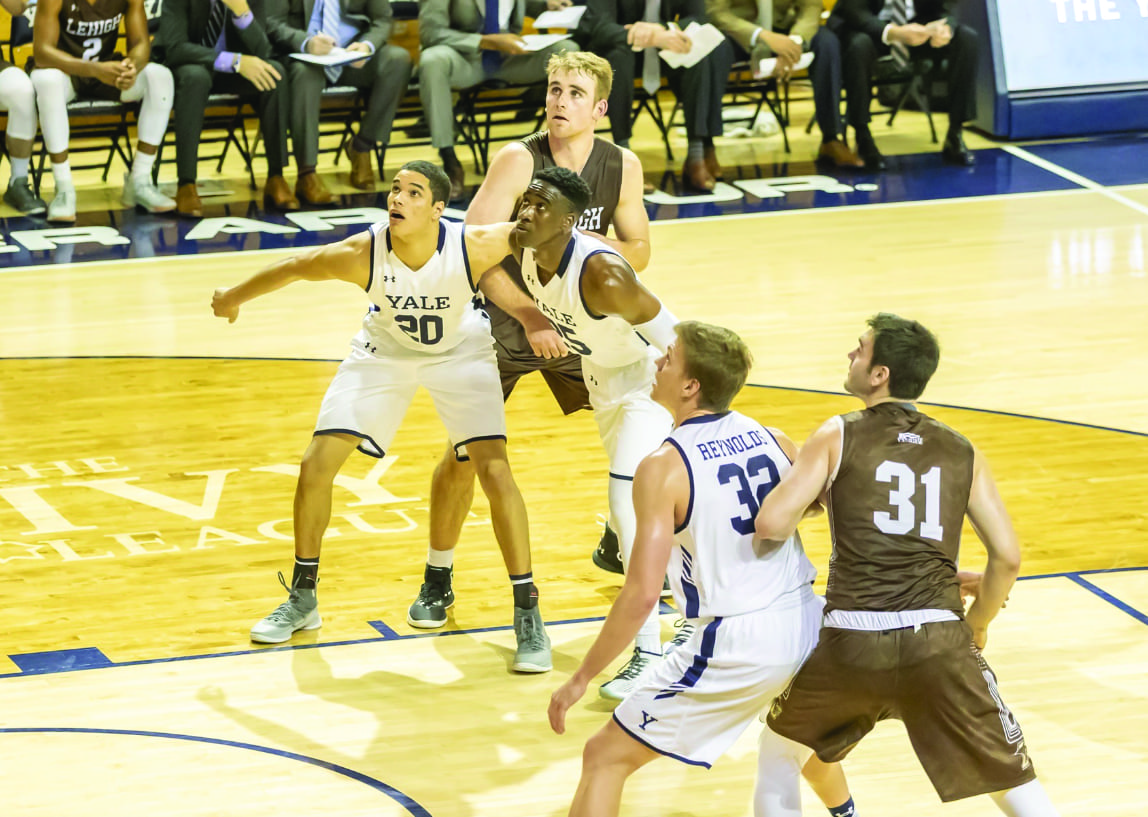
Courtesy of Steve Musco
Yale men’s basketball head coach James Jones employs a three-pillared approach to basketball, one that emphasizes team defense, crashing the boards and moving the ball.
His mantra — “Defend. Rebound. Share.” — is inscribed throughout the team’s locker room along the redesigned Corridor of Champions, encapsulating keys that the Bulldogs take to heart every game. With just two regular season games to go, Yale leads the Ivy League in all three statistical categories: opponent field goal percentage, rebounds per game and assists per game. Even on a veteran team with professional talent and refined technique, the rebound — in all its simplicity — has perhaps emerged as Yale’s greatest asset.
“We have three functions in which this team tries to play on, or three philosophies,” Jones told the News in early December. “Defending, rebounding and sharing the ball … so if we’re not doing those things, we’re not being true to ourselves, and I think that our guys have bought into who we are and have tried to the best of their abilities to work that way during games.”
Yale ranks second among all 351 Division I NCAA teams this season with 30.64 defensive rebounds per game — just 0.01 behind South Dakota State — a top mark that the Bulldogs have maintained for a large portion of the 25 games they have played thus far. Yet as those familiar with Jones and the program know, the Elis’ success in boxing out opponents and snagging the ball after forcing misses is no coincidence.
In 2016, the Bulldogs captured their first-ever win in an NCAA Tournament game, a four-point upset of fifth-seed Baylor in which the Elis outrebounded their Big 12 opponents 36–32. A reporter infamously asked Baylor forward Taurean Prince how Yale, of all schools, outrebounded the Bears. The 6-foot-8-inch, 220-pound Prince, who finished his final game in a Baylor jersey with 28 points but just four rebounds, responded with an answer that went viral.
“You go up and grab the ball off the rim when it comes off, and then you grab it with two hands,” Prince said, complementing his words with hand gestures. “And you come down with it, and that’s considered a rebound. So they got more of those than we did.”
Yet outrebounding their formidable Big 12 opponent on college basketball’s biggest stage was not just an outlier but instead a deep part of the team’s ethos. Yale had led the Ivy League that season with 40.3 rebounds a game, accumulating an average rebounding margin of +10.9, nearly four times higher than the +3.0 mark Harvard posted in second place. In fact, from the 2011–12 season until the present, last season was the only year in which the Bulldogs did not lead the Ancient Eight in rebounding margin.
The whole coaching staff, including assistant coach, post-player specialist and Jones’s former forward Justin Simon ’04, has taken up the head coach’s doctrine.
“Coach Jones has kind of created this environment where you got the other coaches preaching to us about rebounding and being strong with the ball,” forward Paul Atkinson ’21 said. “As a unit, they all work together to make sure we’re all rebounding… I don’t know exactly when it started for him, but as long as I’ve been here at Yale, it’s always been a part of our philosophy.”
This season, the Elis boast two players, guard Miye Oni ’20 and forward Jordan Bruner ’20, who rank in the top-10 of the conference in rebounds per game, while Atkinson adds 5.3 a game. Bruner ranks 63rd in the nation with 8.6 rebounds per game. Meanwhile, Oni, who snags 6.5 rebounds a night, often pushes the ball up the court after grabbing a board, adding another dimension to the overpowered Eli offense — a defensive rebound can result in a lethal Euro step layup at the rim or an alley-oop pass to one of the big men in a matter of seconds.
But when you look at a box score after any game, players across the roster — from 6-foot guard Azar Swain ’21 to the 6-foot-10-inch Atkinson — all crash the glass. Atkinson said Jones and the entire coaching staff expect all five players on the floor to hustle after the ball. And the Elis take it personally when opponents beat them there.
“We try to gang rebound so a lot of it’s with the guards too,” Bruner said. “As long as everybody does their job, usually everybody only has one man to box out. I know we kind of take it personally if anybody gets an offensive board on us, and I don’t know if that’s anybody else’s mentality, but that’s the way Coach Jones drills it into us into our mindsets, so we just try to take pride in getting every ball that comes off the rim whether it’s ours or theirs.”
Constant focus on crashing the boards during practice supplements the vocal repetition of Jones’s ideology, raising an Ivy League program to the top of the nation’s rebounding rankings. During every facet of practice, from simple drills to full-team scrimmages, the emphasis has created a rebounding instinct that has become second nature for most.
Yale owns zone defenses, complicated presses and final-second plays in its repertoire, but its record proves that the rebound alone dictates Yale’s success. When outrebounding opponents this season, the Elis are 18–1. When outrebounded? 0–4.
“I feel like the only time I truly don’t play well is when I don’t defend well like I can and don’t rebound like I can,” Oni said after the program’s second loss to Harvard. “Because those are the things that you can control. Shots going in, shots not going in, it’s going to come, it’s going to go, you can’t really control that the way the ball bounces. But defense and rebounds you can always control.”
William McCormack | william.mccormack@yale.edu
Cristofer Zillo | cris.zillo@yale.edu







